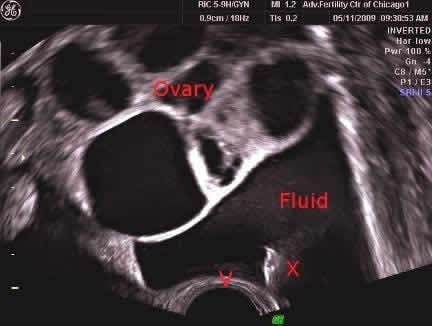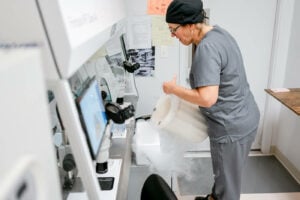- Ovarian hyperstimulation syndrome, or OHSS, is a condition with enlarged ovaries and fluid build up in the abdominal cavity
- It occurs over a period of several days after egg retrieval, or in very early pregnancy
Problems seen with OHSS can include:
- Lower abdominal distention (bloating)
- Abdominal pain
- Nausea with possible vomiting
- Diarrhea
- Sensation of difficulty breathing – due to pressure from ovaries and fluid on the diaphragm (breathing muscle)
Abdominal distention is very common after stimulating the ovaries with injectable medications. Therefore, abdominal distention alone does not make “hyperstimulation syndrome”. The best way to deal with ovarian hyperstimulation is to avoid it in the first place – stimulate the woman very cautiously with the injectable medications.
How to prevent ovarian hyperstimulation syndrome with a Lupron trigger
OHSS of a significant degree occurs in a small percentage of women after they are stimulated with injectable FSH (gonadotropins). When it occurs it is usually after stimulation done for in vitro fertilization. It is very rarely seen with Clomid use.
Women with polycystic ovarian syndrome, PCOS and high antral follicle counts are at much higher risk for this than the average IVF patient.
There is quite a spectrum of severity with hyperstimulation. It can be very mild – or it can be moderate or severe. Mild OHSS is very common and occurs in up to about 35% of cases of ovarian stimulation. The mild form is so common that it is considered almost a “normal” situation after ovarian stimulation.
Mild and moderate cases are managed with observation – often including an exam by the doctor, ultrasound evaluation, and sometimes blood work.
Severe cases sometimes will require hospitalization and/or paracentesis – a procedure to drain excess fluid from the abdominal cavity (see below).
Ultrasound picture of a hyperstimulated ovary and free fluid in the abdomen
Ovarian ligament with doppler blood flow shown by red and blue colors
Ovary has cursors on it – measures 7.1 by 6.4 cm in diameter
Fluid is the black area around the ovary
Why does OHSS occur?
OHSS is caused by a process that results in “leaky” blood vessels. In doctor terminology we say that there is increased capillary permeability and fluid shifting from inside blood vessels into “3rd space” compartments.
Several substances seem to be involved in causing the OHSS process. It is currently believed that increased levels of vascular endothelial growth factor, or VEGF, are a major cause of the development of OHSS.
Management of OHSS
Mild to moderate OHSS is usually managed with education of the patient about expectations and oral pain meds. Sometimes women will need to be off of work for a few days or so.
If the OHSS process worsens a more thorough evaluation is done. This would often include:
- Physical examinations and ultrasounds to measure the ovaries and assess free fluid
- Daily weights (another measure of how much free fluid is building up)
- Blood work for CBC, electrolytes, and creatinine
Hospitalization
If hyperstimulation increases to a severe situation, hospitalization might be needed. There are no absolute rules for this, but hospitalization is often considered with one or more of the following:
- Severe abdominal pain
- Severe nausea and vomiting
- Very low blood pressure
- Severe abnormalities on blood test results
- Extremely low urine output
Paracentesis
Sometimes when OHSS is moderate to severe, removing some free fluid from the abdominal cavity is done to give the woman relief from the symptoms – and to try to reverse the progress of the OHSS condition.
Paracentesis is done using ultrasound guidance so that we can place a needle safely into the abdominal cavity and monitor the progress of the fluid removal. We often call this “tapping” the patient – to remove fluid.
Picture showing paracentesis being done for OHSS
Enlarged ovary at left, top of the vagina at V
The needle is the white line at the left of the red X
2 liters of fluid was slowly aspirated from this patient’s abdomen
How to prevent ovarian hyperstimulation syndrome
OHSS is best prevented by very careful use of injectable FSH medications in women at risk for hyperstimulation in conjunction with proper utilization of an agonist (Lupron) trigger at the time of triggering egg maturation.
Evaluation of risk factors for developing OHSS and choosing the best ovarian stimulation protocol and proper drug dosing. Risk factors that fertility specialists should look at to predict who is at higher risk for OHSS include:
- High antral follicle counts
- High AMH blood level
- High LH blood level, and high LH to FSH ratio
- All of these factors are also useful for estimating an ideal dose of injectable FSH drug
Monitoring of the response to the injectable meds should be done carefully with more frequent monitoring visits for patients at higher risk for hyperstimulation. Adjusting the dose carefully during the stimulation process is important to reduce the risk for overstimulation.
There are other methods used by fertility specialists to reduce or eliminate the risk for developing ovarian hyperstimulation syndrome:
- Using a Lupron trigger to induce an LH surge (instead of giving the HCG shot)
- This can only be done if the patient has not been down regulated with Lupron for the IVF stimulation
- Our research study on high IVF success rates using Lupron triggers
- “Coasting” the patient for 1-3 days without any further FSH drug injections before giving the HCG trigger shot – if there are many follicles and a high estradiol level
- Giving less than the standard 10,000 unit dose of HCG for the trigger (for example, using 5,000 units)












